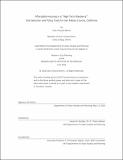Affordable housing in a "high-tech Mayberry" : site selection and policy tools for San Mateo County, California
Author(s)
Morris, Ellen Victoria
DownloadFull printable version (25.61Mb)
Alternative title
Site selection and policy tools for San Mateo County,
Other Contributors
Massachusetts Institute of Technology. Department of Urban Studies and Planning.
Advisor
James M. Buckley.
Terms of use
Metadata
Show full item recordAbstract
California's Affordable Housing & Sustainable Communities (AHSC) program offers gap financing to affordable housing developments and infrastructure projects that demonstrate reductions in greenhouse gas emissions. Funded through revenue from the state's carbon cap-and-trade market and motivated by statewide requirements to incentivize compact infill development near transit, AHSC challenges affordable housing developers, transit agencies, and city staff to work collaboratively to address issues of congestion, displacement, and transit access in the context of far-reaching sustainability goals. However, AHSC requirements in its inaugural year (2014-2015) favored projects in California's largest, densest cities, leaving suburban communities skeptical of their ability to tap into the state's largest new pot of funding for affordable housing. One such place is San Mateo County, California, the suburban region on the San Francisco Peninsula that connects San Francisco to San Jose and Silicon Valley. It is within the context of the AHSC program in San Mateo County that I pose the question: to what extent should affluent suburban communities assume a portion of the region's overall housing needs? I consider three scholarly discussions -- suburbanization of poverty, spatial mismatch theory, and exclusionary housing policy -- together to forge an alternative conception of affluent, transit-rich, and diverse inner-ring suburbs and their obligations to steward affordable housing development. To implement this conception on the ground, I consider the opportunities and barriers to affordable housing development in San Mateo County, identify sites that would be competitive for future rounds of AHSC funding, and propose policies and programs to protect critical sites.
Description
Thesis: M.C.P., Massachusetts Institute of Technology, Department of Urban Studies and Planning, 2016. This electronic version was submitted by the student author. The certified thesis is available in the Institute Archives and Special Collections. Cataloged from student-submitted PDF version of thesis. Includes bibliographical references (pages 89-97).
Date issued
2016Department
Massachusetts Institute of Technology. Department of Urban Studies and PlanningPublisher
Massachusetts Institute of Technology
Keywords
Urban Studies and Planning.